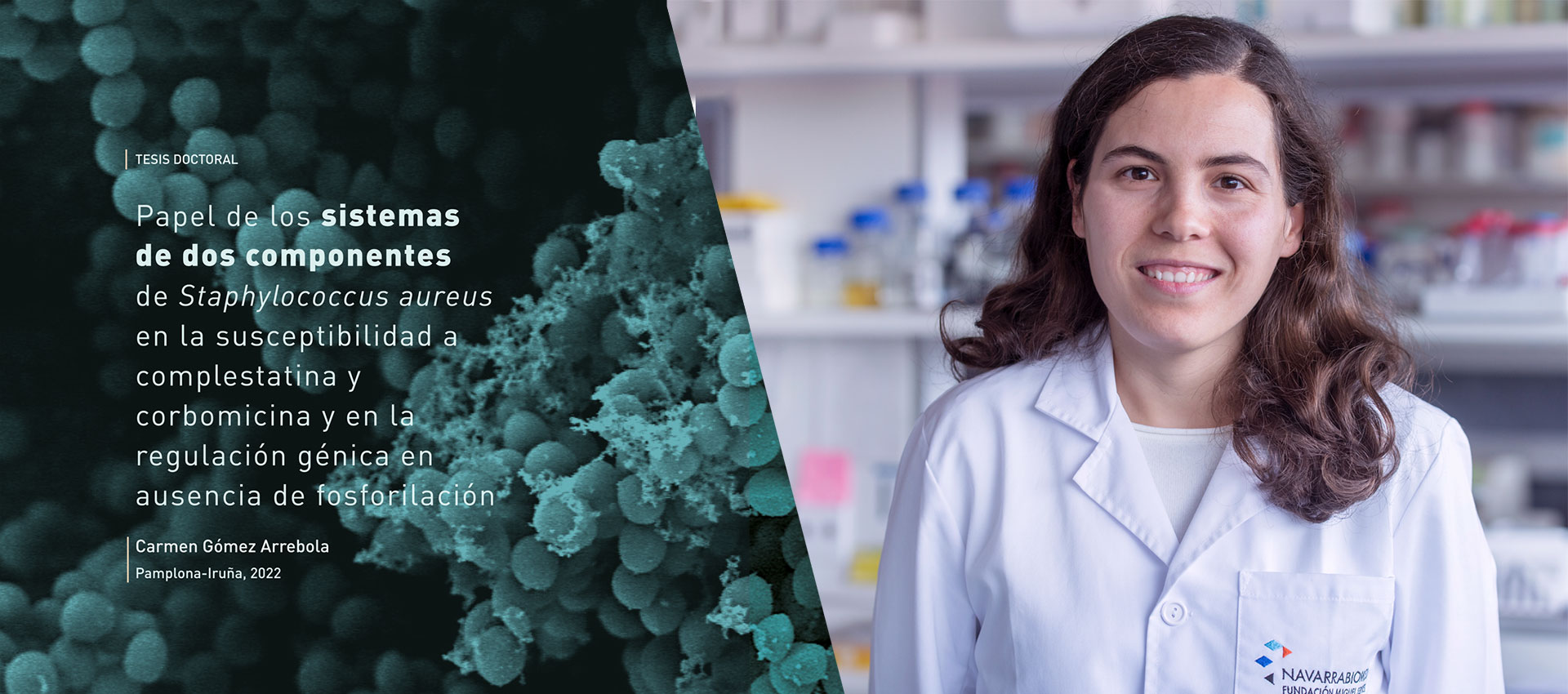
Carmen Gómez will present her doctoral thesis on Tuesday, July 5th
Carmen Gómez Arrebola, predoctoral researcher at the Microbial Pathogenesis Research Unit of Navarrabiomed, will be sitting her viva (Public University of Navarra) next Tuesday, July 5th at 11:30 in the examination hall of EDONA, Edificio El Sario (UPNA).
The doctoral work, entitled "Role of the two-component systems of Staphylococcus aureus in the susceptibility to complestatin and corbomycin and in gene regulation in the absence of phosphorylation”, has been developed at Navarrabiomed under the direction of Dr. Iñigo Lasa Uzcudun and Dra. Cristina Solano Goñi.
Staphylococcus aureus (S. aureus) is a versatile bacterium that can be found as a commensal on the skin of approximately 30% of the population without causing any problems. However, when it crosses the epithelial barrier and depending on the carrier's immune status, it can cause mild pathologies, such as abscesses, or severe ones, such as endocarditis or osteomyelitis. There is a wide range of drugs for the treatment of these pathologies, however, S. aureus has developed mechanisms that allow it to increase its resistance and evade the effect of these antibiotics.
Bacteria have the ability to adapt to the changes that occur around them thanks to different detection and communication systems, including the so-called “two-component systems” (TCSs). Through them, the bacteria perceive what is happening around them and by modulating the expression of certain genes, can adapt to the changes occurred. The TCSs of S. aureus they have a very important role in the development of resistance to the various antimicrobials currently used in the clinical setting, as well as in the stimulation of growth in the form of biofilm, further increasing their resistance to antibiotics.
The appearance of strains of multidrug-resistant S. aureus has led to the alarming need to develop new antibiotics that allow the treatment of infections caused by these strains, as well as the need for progress in our knowledge on the molecular mechanisms that produce this increased resistance.
Thesis abstract and results
During her doctoral thesis, Carmen Gómez has analysed the involvement of the TCSs of S. aureus in the susceptibility to two antibiotics of the glycopeptide family, complestatin and corbomycin, recently discovered. The results have shown that the VraSR system regulates elements of the bacterial wall that affect the susceptibility of this bacterium to both antibiotics.
Another part of the study has been devoted to analyse the regulation by TCSs in their non-phosphorylated form. It has traditionally been considered that the response regulators of TCSs exercise their regulatory function in their phosphorylated state, and that in their non-phosphorylated state, they have no regulatory activity. However, considerable evidence shows that TCSs in their unphosphorylated state also exert gene expression modulation functions. After a review of the existing evidence regarding the regulation by TCSs in their non-phosphorylated state, the work has delved into the regulation of biofilm formation by ArlRS TCS. The results obtained suggest that ArlR regulates the expression of the main exopolysaccharide of the S. aureus biofilm in both its phosphorylated and non-phosphorylated state.
Disclosure and financing
The work carried out has led to the scientific publication, “Regulation of gene expression by non-phosphorylated response regulators”, published in International Microbiology. A second publication entitled “Staphylococcus aureus susceptibility to corbomycin and complestatin depends on the VraSR two component system” has been submitted and is in the process of being reviewed.
In addition, it has been disseminated at the 31st European Congress of Clinical Microbiology & Infectious Diseases (ECCMID) and the XXVIII Congress of the Spanish Society of Microbiology.
For the development of the thesis, Carmen Gómez had a predoctoral contract from the UPNA. Research has received funding through the calls for Aid to R&D&i projects 2017 of the Ministry of Economy, Industry and Competitiveness and Aid to R&D&i projects 2020 of the Ministry of Science and Innovation, granted to the projects:
- “Functional characterization of the molecular determinants for the adaptation of Staphylococcus aureus to virulence”. BIO2017-83035-R.
- “Non-contiguous operons: a new level of gene regulation in bacteria”. PID2020-113494RB-100.

